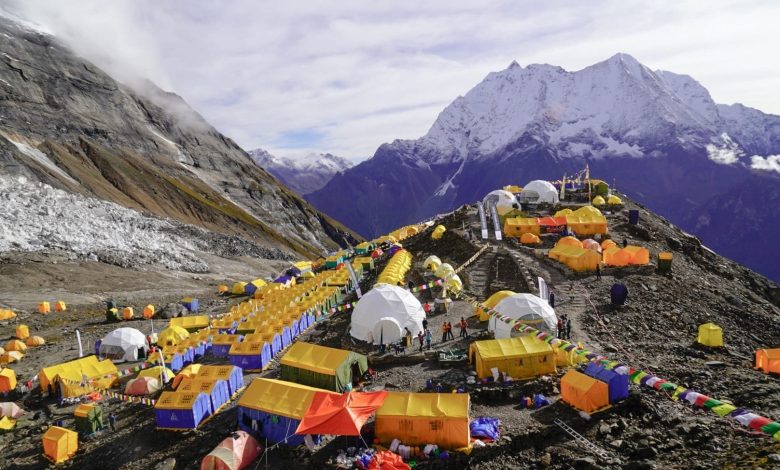What to Expect on Your Everest Base Camp Trek A Sherpa’s Perspective

To trek to the Everest Base Camp is an awe-inspiring adventure, and few people get to experience it through the eyes of a Sherpa. The indigenous people of the Khumbu are the Sherpas, who know the mountains, the trails and the people who pass over them as intimately as they know their own homes. Right from the first steps of your trek, the expertise of a Sherpa guide helps set the tone for a safe and enjoyable experience.
As you work your way through the rough and tough series of steps, your Sherpa will accompany you to make sure that you’re scaling even the toughest section with relative ease and confidence. Sherpas know all about the challenges of high-altitude trekking, including steep climbs, erratic weather, and altitude sickness. They are trained to keep everyone moving at an achievable pace, ensuring that you take the right breaks, and drink sufficient water to prevent fatigue and related illnesses from altitude. Their intimate knowledge of the trail allows them to adapt their itinerary to accommodate weather conditions and trail difficulty, keeping you safe and comfortable at all times.
Everest Base Camp with Kala Patthar In addition to guiding, Sherpas provide an invaluable cultural perspective. They talk about their mountain heritage the importance of sacred sites, and their deep spiritual connection with Mount Everest. As you make your way past quaint villages and Buddhist monasteries, your Sherpa will explain the spiritual significance of those stops, meaning that the trek is as culturally enriching as it is physically challenging.
During the trek, your Sherpa will be both a guide and a source of emotional support. During difficult times, when fatigue or doubts come in, they are the ones providing words of encouragement, knowing exactly when to tell you to push a little harder in order to achieve the goal. But the relationship between a trekker and their Sherpa is one of trust, respect and shared determination. The Everest Base Camp trek, from their view, is more than a physical challenge—it’s a chance to share their world, their traditions, and their love of the Himalayas.
Introduction: The Role of a Sherpa in Your Journey
The importance of a Sherpa in completing a trek to Everest Base Camp or any Himalaya venture, cannot be underestimated. Sherpas are far more than guides — they’re local experts, familiar with the mountains, weather patterns, culture, and the physical rigors of high-altitude trekking. (Sherpa is a term used for the indigenous people of the Khumbu region of Nepal, where Mount Everest is located; they are known for their physical endurance, their high-altitude expertise, and their cultural affinity with the mountains.)
Everest Base Camp Trek Weather When trekking they are navigators, cultural guides, safety officers, and even emotional support. They have an unmatchable skill to lead in difficult terrain, unforgiving weather and at the altitude. For trekkers, Sherpas are more than just companions on the trekking journey; they are vital partners that make the trek safe and scalable while also enjoyable. Their familiarity with the trail, ability to handle emergencies, and understanding of the trekker’s needs make them key to any successful expedition. Sherpas provide a unique perspective of the mountains and the trek itself from the lens of local history, culture, and personal stories, enriching the experience. They are the trusted guides who help trekkers navigate the literal trail to Everest Base Camp as well as the significant cultural and spiritual journey that accompanies them.
Know Before You Go: Preparation for the Trek
Preparation for the Everest Base Camp Trek is a physical and mental challenge. This iconic trek requires an extraordinary level of physical fitness, including endurance and the ability to adapt to punishing elements, especially at altitude. Preparation starts with getting into shape physically; a mix of cross-training, strength workouts, and hiking practice is key. For steep inclines—and long days of walking—trekkers would be wise to focus on building leg strength and cardiovascular endurance.
Trekkers must also prepare in terms of packing for the trek apart from physical preparation. It’s imperative to carry lightweight weather-specific gear, such as a good-quality sleeping bag, ample hiking boots, and layered clothing for varying temperatures. Other basic gear includes trekking poles, water bottles, and a first aid kit.
Everest Base Camp Short Trek Being informed about the possibility of altitude sickness is another important part of preparing. It’s crucial to use proper acclimatization before undertaking these challenges and to take time ascending with plenty of rest days in between. It is strongly advised to hike with a guide (ideally a Sherpa). They have the know-how to facilitate acclimatization and give pacing advice so that trekkers will be able to avoid altitude sickness and stay safe. Make sure to get the right permits and that your travel insurance includes trekking to high altitudes. Advance preparation not only ensures physical readiness but also enables trekkers to enjoy the journey in its true spirit, with the confidence of being well-equipped for the adventure that lies ahead.
A Sherpa’s Perspective on Trekking Challenges
The Everest Base Camp Trek is not just about carrying impossibly heavy loads across arduous terrains from a Sherpa’s perspective. Sherpas, locals who have lived in the Khumbu region, know the altitude, weather, and terrain well. But for them, the trek is still hard — just as through a different lens than trekkers.
Weather is one of the biggest challenges for Sherpa. Weather in the Himalayas can be unpredictable, with sudden storms and temperature changes that can affect both trekkers and Sherpas. In often treacherous high-altitude environments, Sherpas must remain on guard at all times, constantly readjusting to unintended changes in weather.
There’s also the physical challenge of leading trekkers with heavy loads. Sherpas typically carry 30 kg or more, climbing hours a day at high altitudes. And even though they have long since acclimatized to the thinner air, that strain can take a toll on long distances. Management of the emotional and psychological aspects of the trek is another task for Sherpas. Many trekkers aren’t prepared for the mental and physical exhaustion that kicks in and the Sherpas have to offer constant encouragement, motivation, and reassurance, often leading trekkers through their doubts or depletion.
This perseverance is complemented by their unwavering dedication to their position, which is critical to ensuring that treks go as smoothly as possible while keeping themselves safe and healthy the entire time.
Sherpas Coped With Two Years of Mile High.[Meet the Sherpas Who Work at Mile High.
Short Everest Base Camp Trek When it comes to any trek in the world especially Everest Base Camp, acclimatization is the most important thing and whether people like to admit it or not, the sherpas make a significant difference in helping trekkers cope with altitude. As hikers climb to higher altitudes, the air gets thinner and it becomes harder for the body to obtain the oxygen it requires. Which is when altitude sickness can become a serious risk. The Sherpas are extremely familiar with the symptoms of altitude sickness and have been trained to take early intervention measures.
Sherpas often use the “climb high, sleep low” method to help trekkers acclimatize. This means climbing high during the day and coming back down to sleep low. This enables the body to acclimatize to the thin air without putting too much strain on it. There are planned strategic rest days in the trek where trekkers stay at the same altitude for a day to acclimatize to the altitude.
Sherpas also pay careful attention to trekkers’ health and offer reminders about hydration, nutrition, and pacing, further mitigating the risks of altitude sickness. By slowly gaining altitude and allowing trekkers to rest at key stages, Sherpas help minimize the harmful impacts of high-altitude environments. They’re knowledgeable and understand altitude management, key to the success of the trek.
When you go Trekking Daily, Here is What to Expect
A day on the Everest Base Camp Trek is fairly routine, although this varies depending on the weather, terrain, and the speed of the group. Trekkers wake up early in the morning usually at around 7 AM followed by breakfast at the teahouse/lodge. This may consist of traditional meals such as oatmeal, eggs, bread, and tea, supplying you with the energy needed for the hike ahead.
The daily hike can vary, but generally takes anywhere from 5 to 8 hours, depending on distance and elevation gain. The route varies from easy, clearly marked trails to steep, rocky inclines, including several ups and downs during the day. As they do, Sherpas make sure to keep an even pace so that no one burns out. Trekkers often break for short amounts of time several times each day to hydrate, snack, and enjoy the breathtaking landscape, which consists of forests, rivulets, and alpine villages framed by snow-capped peaks.
Everest Base Camp Trek Accommodation Lunch (often between 12 and 2:30 pm) is taken in one of the many teahouses en route, a welcome opportunity to rest and refuel. The trek continues, the altitude rises and the scenery becomes more rugged. By late afternoon, trekkers typically reach the next lodge or teahouse, where they can unwind and eat a hot meal before a well-deserved night’s sleep. Trekking is also weighed against acclimatization, where rest days along the way help with adjustment to the altitude and the group’s safety.
Traversing the Terrain: A Local Sherpa’s Know-how
Sherpas have incredible knowledge of the rocky, often unpredictable paths that lead to Everest Base Camp. And it’s a life-or-death skill not only for themselves but for the trekkers they lead. The trail to Everest Base Camp is a physically demanding one filled with steep slopes and rocky streets, volatile weather, and altitude-related illnesses. Sherpas know each twist and turn and climb along the route so well. Their adeptness in traversing these hostile environments is crucial to ensuring that the trekkers remain on course and are able to reach their destination successfully.
The ability to navigate comes with an understanding of how the terrain changes over time, which is one of the aspects of building navigation skills as a Sherpa. Mountain trails can be affected by seasonal factors, such as the snow fall or rockslides, that a trail guide may need to assess in real time; Sherpas are particularly well trained in doing this. Crossing narrow suspension bridges, navigating paths covered with glacier debris, stepping over rocky ledges near Everest Base Camp: In each case, Sherpas are trained to pick the combination of routes that’s safest and quickest.
Everest Base Camp Trek Preparation Sherpas also have a unique talent for making sure that they adapt to the physicality of the trek, modifying the speed and rest stops in accordance with the terrain and the physical condition of the trekkers. Emphasis is placed on route knowledge, allowing them to read their environment and keep the group on track, and this care is compounded by avoiding dangerous situations and the reward of a perfectly timed tea ceremony.
Cultural Insights: Sherpa Communities on the Way
One of the most enriching experiences of the Everest Base Camp trek is the cultural immersion with the indigenous Sherpa people. The Sherpa people, who are native to the Khumbu area, are deeply spiritual and historically connected to the mountains, and they live in tight-knit communities along the trekking path. Sherpas are warm, hospitable, and generous, sharing traditions, customs, and spiritual practices as you walk through villages. Throughout the trail, you come across Buddhist monasteries, prayer flags, and stupas — all important parts of the Sherpa people’s belief system. While Sherpas usually give the meaning of all these sacred areas, and notation gives trekkers the culture of Mount Everest and its spiritual meaning. Or you might listen to stories handed down through generations of legendary Sherpa mountaineers and their fantastic accomplishments, roped in spiritual ties between the community and the peaks. Your Sherpa guide — who is likely from one of these communities — is an invaluable resource for understanding the local way of life. The trek is about much more than a quintessential physical challenge, however: It is also about experiencing the hospitality, resilience, and respect of the Sherpa people, so the journey becomes both a cultural and spiritual experience.
Trail Safety and Risk Management
Everest Base Camp trek challenge: Well, there are many challenges like altitude, terrain, and weather conditions. Sherpas in particular help to mitigate the dangers of this hike, and safety first and foremost is most important. Having been born and raised in the area, Sherpas are familiar with the local terrain and Himalayan conditions. They know the risks, from unstable rocks, slippery surfaces, and erratic weather patterns, and how to guard against them. The Sherpas’ responsibilities go beyond leading you on the trail; they’re also charged with keeping you safe at higher altitudes. Altitude sickness can be serious, so Sherpas keep a close eye on trekkers, adjusting the pace to allow for proper acclimatization and making sure trekkers are hydrated and well-rested. They are familiar with the symptoms of altitude sickness, and trained to deal with medical emergencies, including knowing when it is better to descend to a lower altitude for treatment. They are also adept at group dynamics, pacing, and preventing people from being dropped. They will check in often to evaluate trekkers’ well-being and make sure they’re physically and mentally equipped to carry on. Their top priority is always the safety of trekkers and they have the general knowledge to mitigate risks so that you are free to enjoy the trek without unnecessary fear.
Moving Through the Emotions: Mental Support From Your Sherpa
It requires a lot more than just physical fitness which tests the emotion level. As trekkers force their bodies over the brutal terrain and to dizzying altitudes, mental resilience becomes as crucial as physical stamina. This is where the Sherpas come in — they are invaluable. They have already gotten to know the mood of the trek and what it demands from your heart, thus are capable of offering you nonstop emotional support, ensuring you stay healthy and optimist through glacier-like ascent and with the environment sometimes firmly opposing your plans. Trekking in such a remote and arduous environment can induce fatigue, homesickness or doubt. Sherpas play a specific role in combating these mind games, reassuring trekkers and encouraging them to continue. They are there to huddle, or offer advice, or just sit and share a moment when the road is rough. More than just direct experts in the physical journey, however, Sherpas act as emotional life rafts, encouraging trekkers to stay positive and persevere through tough moments. They’re also great at pacing a group, keeping things at their speed so others don’t feel overwhelmed. Their ability to sense a trekker’s mental state allows them to offer the right support at the right moment, whether it be a quick pep talk or a brief moment of quiet rest. Such emotionally charged supports are of utmost importance for ensuring that the trek is not only a physical success but also a deeply rewarding experience for the climbers, as they bond with their Sherpa and the climb in ways that move beyond just muscles and lungs.
Eating, Relaxing, and Sleeping Along the Way
As much as the Everest Base Camp trek can be physically taxing, Sherpas knows how to strike a balance between these efforts and moments of rest, which is key to keeping energy levels up during the trek. The trek is strenuous, with long walking days, but the Sherpas ensure that meals and rest places are timely and bountiful. Meals are usually available at local teahouses dotting the route, and Sherpas help ensure that you eat foods that will give your body energy to carry you through the next stage of the trek. Traditional dishes such as Dal Bhat (lentil soup served with rice) give you plenty of energy, and so this is what is often served, as well as a selection of other local and international foods. This means drinking enough water and packing meals (ideally a mix of calories and proteins), ensuring that trekkers do not get dehydrated or fatigued. Aside from food, the other great player in the energy game is rest. Sherpas ferry loads and build rest forays, encouraging trekkers to take breaks along the way lest they become exhausted. There are also planned acclimatization days in the trekking itinerary that are essential to give your body the time to adjust to the increased elevation. At the day’s end, Sherpas will make sure trekkers have comfortable lodging, offering advice on staying warm at higher altitudes, as well as how to slumber well in sometimes basic, but cozy, teahouses. Whether it’s recommendations for making the most of sleeping bags or suggestions on how to alleviate discomfort, the Sherpas offer the direction that makes sure trekkers are rested and ready to tackle the next day’s trek.
The Trek to Everest Base Camp: The Pride of a Sherpa
EBC Trekking Package Getting to Everest Base Camp is the end of a long journey, and for Sherpas, means something deeper than taking the next step. To trekkers, arriving at Base Camp is a victory; for Sherpas, it feels like a returned pride and a connection to the mountains they belong to. For Sherpas, leading trekkers to Everest Base Camp is more than just taking them to a physical place; it’s joining them in the spiritual meaning behind the endeavor. The journey to Base Camp is a sacred experience for many Sherpas, as it’s intricately woven into their heritage and spiritual connection to Mount Everest, which the Sherpas call Sagarmatha in Nepali and Chomolungma in Tibetan. As Sherpa guides trekkers to this iconic location, they often reflect on their individual and cultural lineage to the mountain. As part of a long line of mountain guides, they take great pride in guiding others to the dream of Base Camp. Reaching Base Camp is a moment that is celebrated in both the trekkers’ effort as well as the Sherpa’s commitment to guiding and assisting them through every step of the trek. For the Sherpa, seeing a trekker’s happiness and accomplishment is a victory shared, reaffirming their dedication to the work — and the profound bond they share with the spectacular Everest region.
Lessons Learned — The Perspective of a Sherpa
When trekkers visit the Everest Base Camp, it becomes a life-changing experience but trekking in the rugged terrain through the country is also a journey for the Sherpas that guide many groups every year. Sherpas frequently contemplate the deep lessons they gain from their toil — lessons of resilience, patience, and humility. To them, the trek is more than a workout; it is a deeply spiritual and emotional experience. There are also fellow mostar trekkers from all walks of life with their unique story and stronger motivation to experience the hike. The sight of trekkers persevering through physical limits and mental struggles reminds Sherpas of the resilience of the human spirit. Sherpas also learn from the different cultures and experiences of trekkers they lead and bring new perspectives on life, goals, and dreams. This, in turn, brings them inspiring and new experiences that enhance their own life, garnering a sense of understanding and respect on an individual level that transcends all borders. Also, Sherpas learn a lot about the mountains and nature during these experiences, and to respect nature and that high-altitude ecosystems are fragile. The trek rams home what everyone on that mountain knows — that perseverance, teamwork, and humility are the keys to muscle through that which tests our mettle. Guiding people to Everest Base Camp is more than a job for Sherpas: it’s a meaningful calling that brings purpose and fulfillment that connects them to both the mountains and the people they guide.









